
Kooser State Park is a 250-acre (101 ha) Pennsylvania state park in Jefferson Township, Somerset County, Pennsylvania, in the United States. The park, which borders Forbes State Forest, was built in the 1930s by the Civilian Conservation Corps, who also built the 4-acre (1.6 ha) Kooser Lake by damming Kooser Run. Kooser State Park is on Pennsylvania Route 31 a one-hour drive from Pittsburgh. The park is surrounded by Forbes State Forest.
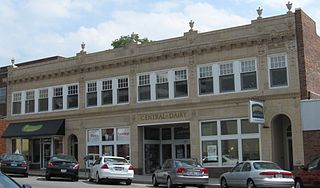
The Central Dairy Building, also known as Downtown Appliance and Gunther's Games, is a historic commercial building located in downtown Columbia, Missouri. It was built in 1927, and enlarged to its present size in 1940. It is a two-story brick building with terra cotta ornamentation elaborate classical and baroque design motifs. Also on the property is a contributing brick warehouse, constructed about 1940. Today the building houses an appliance store and restaurants on the first floor and lofts on the second.
Montgomery Ward Building can refer to:
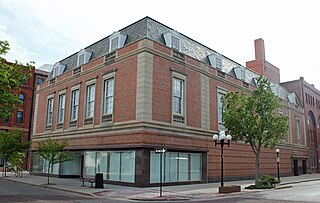
The Montgomery Ward Building is a historic department store building in downtown Pueblo, Colorado. It was listed on the National Register of Historic Places in 1996. Currently used as an office building, it houses the American Bank of Commerce, the Colorado Lottery, and the Pueblo Work Force Center. Previously it was occupied by QualMed as its headquarters.

Montgomery Ward Warehouse and Retail Store is a historic warehouse and retail building in Baltimore, Maryland, United States. It is an eight-story concrete structure and is roughly shaped like a squared-off number "4". The front features a penthouse tower at the main entrance bay with a balcony and capped by a flagpole. The building houses over 1,200,000 square feet (110,000 m2) of floor space flooded by light from approximately 1,000 large multi-paned, steel frame windows. It was built about 1925 as a mail order and retail warehouse for Montgomery Ward on an 11 acres (4.5 ha) site adjacent to the Baltimore and Ohio Railroad tracks. The complex was one of nine large warehouses built by the company in the United States.

The Reymer Brothers Candy Factory in the Bluff neighborhood of Pittsburgh, Pennsylvania, was built in 1906 in the Richardsonian Romanesque style.

Old Downtown Harrisburg Commercial Historic District is a national historic district located at Harrisburg, Dauphin County, Pennsylvania. The district includes 50 contributing buildings in the old central business district of Harrisburg and dating from the late-19th and early-20th centuries. Notable buildings include the Daily and Weekly Telegraph Building (1873-1874), City Bank Building, F.W. Woolworth (1939), Rothert's Furniture Store (1906), Bowman's Department Store, Pomeroy's Department Store, and Doutrich's Clothing Store. Located in the district and listed separately are the Colonial Theatre, Keystone Building, Kunkel Building, and the William Seel Building. The Telegraph Building was delisted after having been demolished.
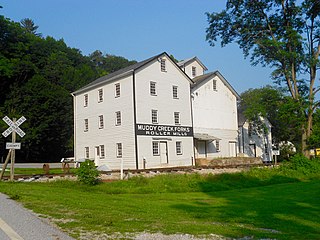
Muddy Creek Forks Historic District is a national historic district located at the Village of Muddy Creek Forks in East Hopewell, Fawn, and Lower Chanceford Townships in York County, Pennsylvania. The district includes 12 contributing buildings, 1 contributing site, and 5 contributing structures. The buildings and structures were constructed between about 1800 and 1935. The buildings include the general store, six houses, a mill, grain elevator, warehouse, and Sweitzer barn. Most of the buildings incorporate Late Victorian style details. The structures are two bridges, a corn crib, a weigh station, and a mill race. The site is the site of a former mill and mill pond.

Samuel N. Mumma Tobacco Warehouse is a historic tobacco warehouse located at East Hempfield Township, Lancaster County, Pennsylvania. It was built about 1914, and is a three-story, three bay by ten bay, rectangular brick building. It has a gable roof and sits on a limestone foundation. It was built for the processing and storage of cigar leaf tobacco.
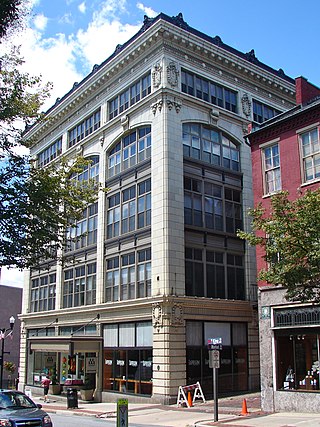
Hager Building is a historic commercial building located at Lancaster, Lancaster County, Pennsylvania. It was designed by noted Lancaster architect C. Emlen Urban and built in 1910–1911. It is a five-story, three bay by five bay, steel frame structure clad in terra cotta in a French Renaissance Revival style. This section of the Hager Building measures 63 feet by 101 feet. The overall dimensions of the building are 240 feet, 6 inches, by 63 feet. This includes the central warehouse section, built between 1860 and 1890, and a brick northern extension built in 1923. The building once housed the Hager Brothers Department Store.

Philadelphia, Wilmington and Baltimore Railroad Freight Shed is a historic freight station located in the Southwest Center City neighborhood of Philadelphia, Pennsylvania, along Broad Street. It was built by the Philadelphia, Wilmington and Baltimore Railroad in 1878, and is a large 1 1/2-story brick and stone building in the Late Gothic Revival style. It measures 99 feet, 5 inches wide and 235 feet long. It has a long, sloping roof supported by a Fink truss system, with glazed monitors.

Wilson Warehouse is a historic combined dwelling, warehouse, and store building located at Buchanan, Botetourt County, Virginia. It was built in 1839, and is a two-story, six bay, brick building in the Greek Revival style. It measures 54 feet by 48 feet
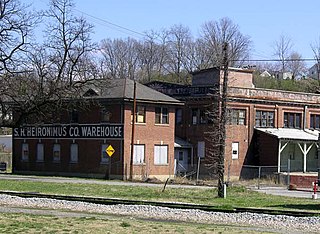
Virginia Can Company-S.H. Heironimus Warehouse is a historic factory and warehouse complex located at Roanoke, Virginia. The "U"-shaped complex was built in 1912, and consists of an office and two factory buildings. All three of the buildings are two stories in height and are constructed of brick on a raised foundation of poured concrete. A second-story pedestrian bridge connects the two factory buildings and a brick hyphen connects the office building to the north factory building. The complex was built for the Virginia Can Company, the first and largest manufacturer of tin cans in Roanoke, Virginia. After 1951, it housed a clothing factory and then the Heironimus department store warehouse.
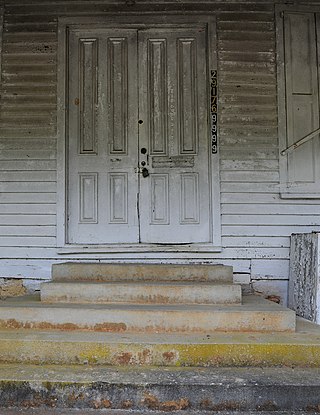
White Oak Historic District is a national historic district located near Winnsboro, Fairfield County, South Carolina. The district encompasses 12 contributing buildings in the rural community of White Oak. The buildings in the district were built between about 1876 and about 1925, and includes three large frame residences, a frame church with steeple, two frame store buildings, a cotton warehouse, and two vacant, wooded lots, some of which reflect Victorian stylistic influences. Notable buildings include the T. G. Patrick Store, McDowell's Store, White Oak Cotton Warehouse, Matthew Patrick House, T. G. Patrick House and outbuildings, and White Oak A.R.P. Church and Manse.

West End Commercial Historic District is a national historic district located at Greenville, South Carolina. It encompasses 15 contributing buildings in Greenville's second "downtown." The commercial buildings primarily date from about 1880 to 1920, and include examples of Victorian commercial architecture. Notable buildings include the American Bank, Alliance and Mills & McBayer Cotton Warehouses, Indian River Fruit Store, Pete's Place, Bacot's West End Drug Store/Stringer's Drug, Furman Lunch, and Greer Thompson Building.
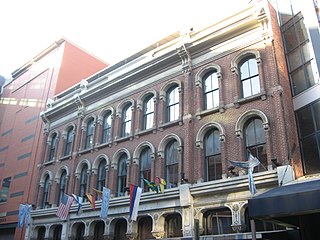
L.S. Ayres Annex Warehouse, also known as Elliott's Block Nos. 14-22, is a historic warehouse building located at Indianapolis, Indiana. It was built in 1875 by the L.S. Ayres department store, and is a three-story, rectangular Italianate style brick building with an elaborate cast iron first story storefront. Other decorative elements are in stone, brick, and sheet metal. It measures 72 feet, 6 inches, wide and 49 feet, 6 inches, deep. It features Corinthian order columns as part of the cast iron facade.
P. C. C. & St. L. Railroad Freight Depot, also known as the Central Union Warehouse, was a historic freight depot located at Indianapolis, Marion County, Indiana. It was built in 1916 by the Pittsburgh, Cincinnati, Chicago and St. Louis Railroad. It was a one-story, brick warehouse building measuring 790 feet long and 70 feet wide. It has been demolished.
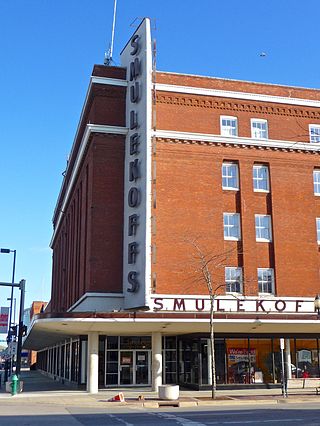
Smulekoffs Furniture Store, also known as the Sinclair Building, New Sinclair Building, Warfield–Pratt–Howell Co. building and the Churchill Drug Co. building, is a historic building located in Cedar Rapids, Iowa, United States. In 1901 Thomas Sinclair had the original section of this five-story brick structure built. It housed the wholesale grocer Warfield–Pratt–Howell Co. and another wholesaler, the Churchill Drug Co. It was the second of several large-scale warehouse buildings that were constructed in this section of the city along the Cedar River. A spur line of the Chicago, Milwaukee, St. Paul and Pacific Railroad was located at the rear of the building. Rosenbaum Furniture Store bought the building in 1925, and it was converted from warehouse use to retail. In 1941 Smulekoffs Furniture Store took over the building and renovated the main floor. They remained here until 2014. The building is slated for apartments on the upper floors and retail on the main floor. It was listed on the National Register of Historic Places in 2016.

The Grocers Wholesale Company Building, also known as the Sears and Roebuck Farm Store, is a historic building located in Des Moines, Iowa, United States. Completed in 1916, this was the first of four warehouses built and owned by Iowa's only and most successful statewide cooperative grocery warehouse. It is possible that it was the first statewide organization of this kind in the country. The cooperative allowed independent grocers to compete against chain stores and survive wholesale grocers' surcharges. They leased their first warehouse after they organized in 1912. Each successive time the cooperative built a new warehouse it was larger and technologically more advanced than the previous one. This particular cooperative grew to include parts of four states: Iowa, southern Minnesota, northern Missouri and eastern Nebraska. They built their second warehouse in 1930 and moved out of this facility. They continued to own this building until 1968, and they leased it out to other firms. The Sears Farm Equipment Store began to occupy the building in 1937 and continued here until 1959. The cooperative became the Associated Grocers of Iowa in the late 1950s, and it continued in existence until 1985. The building was listed on the National Register of Historic Places in 2008.
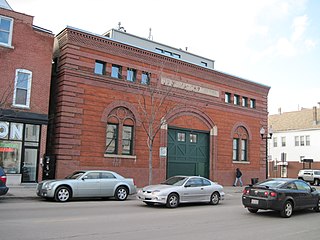
The Mandel Brothers Warehouse Building is a historic warehouse at 3254 N. Halsted Street in the Lakeview neighborhood of Chicago, Illinois. The Mandel Brothers Department Store, one of the oldest department store companies in Chicago at the time, built the warehouse in 1903 to support its delivery service. Prominent Chicago architecture firm Holabird & Roche, who also designed both stores and warehouses for many of Chicago's other department store companies, designed the warehouse. The firm used a Renaissance Revival design for the warehouse, an uncommon choice that stood out from Chicago's many utilitarian warehouses. Their design features a brick exterior with quoins, an arched entrance and windows, and a parapet with decorative brickwork.























